In-Depth
VMware Cloud Foundation 9 Ships
THE major announcement at VMware Explore last year was VMware Cloud Foundation 9 (VCF 9). The objectives of VCF 9 were commendable, with a comprehensive scope. VMware acknowledged that their various tools and navigating and managing hybrid and multi-cloud environments were becoming increasingly challenging. To address this issue, they introduced a unified platform designed to integrate all their enterprise tools to manage private and public clouds seamlessly, from a single interface.
 [Click on image for larger view.]
[Click on image for larger view.]
VMware positioned VCF 9 to answer this demand with a comprehensive platform that consolidates infrastructure management, streamlines operations, and provides flexibility across clouds -- all while enabling control over data, costs, and compliance. To accomplish this, they would build on years of experience to release a VCF 9, which they see as a significant step forward in realizing the vision of an actual hybrid cloud operating model. Today, June 17, 2025, it had GA'ed!
You can read VMware's official blog on it here. But below is my take on it.
A Brief History of VMware Cloud Foundation
Before delving into the details of what made it into VCF 9, let's examine the history of VCF. VCF is currently at version 5.2, but VMware first introduced VCF in 2016. Its mission was to simplify the deployment and lifecycle management of its core infrastructure components: vSphere (compute), vSAN (storage), NSX (networking), and later, vRealize Suite (operations and automation). It was initially targeted at and designed for private cloud environments. Over the years, VCF has evolved through successive versions to provide integrations with leading public cloud providers, including Amazon Web Services (AWS), Microsoft Azure, Google Cloud, and Oracle Cloud.
The laudable goal of VCF has always been to provide a consistent infrastructure and operations model across on-premises data centers and public clouds. With the release of VCF 9, VMware further advances this goal with enhancements in operational simplicity, platform flexibility, and strategic sovereignty, while embracing modern workloads, such as Kubernetes (K8s) and containers, alongside VMware's traditional workload -- virtual machines (VMs). VMware released a beta version of VCF 9 in April of 2025.
One Interface, Many Clouds
The most significant accomplishment of VCF 9 is that it features a unified management interface, not only for its various components but also for hybrid cloud environments. Previously, organizations had to use disparate tools and consoles for their private data centers and public cloud workloads. With VCF 9, VMware delivers a centralized control plane via VMware Aria Suite (formerly vRealize), integrated into VCF to provide operations, automation, and governance across cloud environments.
Its administrators will appreciate this unified interface as it simplifies the management of clusters, workloads, networking, and security policies, regardless of whether the underlying infrastructure is running in their data center or a public cloud. Developers and IT admins benefit from a consistent user experience and API framework that streamlines application deployment and infrastructure provisioning across all the platforms it supports.
In theory, this means organizations can finally reach their lofty goal of deploying an application in a private cloud environment and later move it to the public cloud -- or vice versa -- without having to re-architect the workload or retrain staff. This flexibility accelerates application development and deployment, aligning perfectly with DevOps and GitOps workflows.
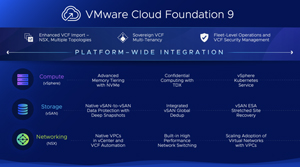 [Click on image for larger view.]
[Click on image for larger view.]
Increased Efficiency
VMware touted some impressive numbers and increased efficiency with this release. A few that caught my eye are around 1% overhead over bare metal, 38% lower memory and server TCO with memory tiering with NVMe, and zero percent downtime for AT with vGPU vMotion optimization.
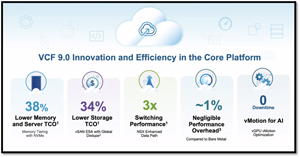 [Click on image for larger view.]
[Click on image for larger view.]
Single Installer for ALL Components
In the past, you needed to use different installers to install the different components that make up VCF. With this release, everything can be downloaded and installed from a single interface. This represents a significant improvement, making installation much easier.
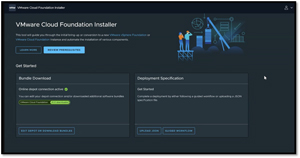 [Click on image for larger view.]
[Click on image for larger view.]
VMs, Containers, and Kubernetes -- Finally Together
Not only does VCF 9 support multiple clouds, but it is also designed to support both traditional and modern workloads. Of course, it natively supports VMs, but it also supports the creation and management of containers, as well as Kubernetes (K8s). This enables organizations to run diverse workloads on a single platform. VMware Tanzu, integrated into VCF, allows teams to run Kubernetes clusters natively on vSphere, providing first-class support for containers without requiring a separate container infrastructure stack.
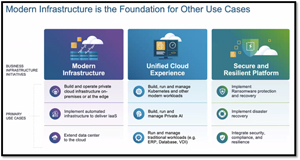 [Click on image for larger view.]
[Click on image for larger view.]
The inclusion of Tanzu Kubernetes Grid in VCF 9 should enable IT teams to provision and manage Kubernetes (K8s) clusters just as easily as they now manage virtual machines (VMs), bringing containers into the fold of enterprise-grade operations, networking, and storage. This convergence enables developers to utilize container-native tools, such as Helm and kubectl, while IT operations teams maintain visibility and control over infrastructure resources.
VCF 9's architecture abstracts away the underlying infrastructure differences between VMs and containers, enabling both to coexist seamlessly. Applications can even be composed of both types of workloads -- monoliths running as VMs alongside microservices deployed in containers -- all governed through the same platform.
Sovereignty and Data Control
Over the past decade, we have witnessed a global tightening of data privacy regulations. In response, we have seen organizations placing increased emphasis on data and operational sovereignty. Whether for compliance with GDPR, HIPAA, or country-specific mandates, enterprises need assurance that their data remains within designated geographic or jurisdictional boundaries and that trusted entities manage their cloud operations.
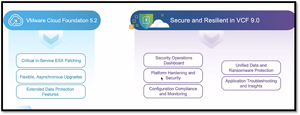 [Click on image for larger view.]
[Click on image for larger view.]
VCF 9 addresses this need by enabling sovereign cloud architecture, where the infrastructure is either hosted on-premises or in certified sovereign cloud environments provided by VMware's extensive network of cloud service providers. These providers adhere to strict controls regarding data residency, access, encryption, and legal jurisdiction, ensuring enterprises meet their regulatory obligations.
To further support this goal, VCF 9 supports isolated management domains, role-based access control (RBAC), and policy-based governance, which enable organizations to tightly control who can access data, how it is processed, and where it is stored. This aligns with industry requirements for zero-trust architecture, enhancing operational security across multi-cloud environments.
Cost Visibility and Control
One of the biggest headaches and challenges in hybrid and multi-cloud environments is the lack of cost predictability. There are many jokes about how public cloud services can lead to unexpected expenses. But many truths are said under the guise of a joke. Public cloud expenses can go off the rails when services aren't right-sized or resources are left running unintentionally. VCF 9 addresses this challenge with cost visibility, optimization tools, and flexible deployment options.
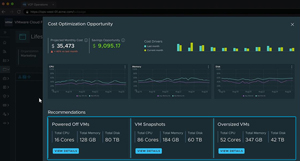 [Click on image for larger view.]
[Click on image for larger view.]
Through VMware Aria Cost and Aria Operations (formerly known as CloudHealth and vRealize Operations), VCF 9 provides organizations with deep, near-real-time insights into the cost of workloads across both private and public cloud environments. Managers can gain insights into their public and private expenditures, track usage trends, allocate costs to departments or projects, and receive recommendations for rightsizing workloads or reclaiming unused resources from the same interface they use for all other operations.
Building on this, VCF allows organizations to move workloads between environments based on cost considerations. For instance, an organization may run development workloads in a lower-cost private cloud and burst into the public cloud for production scaling during peak periods. The consistent platform and management tools make such transitions smooth and cost-effective. This feature has long been the goal, but now it may finally become a reality. This is one of the features that I will be keeping an eye on to see if it does play out as advertised.
Since Broadcom acquired VMware, there has been no shortage of discussion around the licensing of VMware. VCF 9 introduces enhancements to licensing flexibility, including subscription-based models and integration with VMware Cloud Universal, which allows customers to purchase licenses once and apply them across multiple environments, thereby reducing waste and improving visibility into license usage.
Final Thoughts on VCF 9
VMware has promised a lot when it first announced VCF 9 a little over a year ago, and it looks like all that it has delivered on that promise, as well as everything discussed, has made it into the release of VCF 9. With it, VMware has a powerful, unified cloud platform that brings together the best of private and public cloud infrastructures. It supports a wide range of workloads -- from legacy virtual machines to cloud-native containers -- while offering the governance, cost control, and flexibility that enterprises require in a modern IT environment.
I just touched on the highlights of VCF 9. To see more information about it, visit their official website here.
Undoubtedly, VCF 9 will be of primary importance at VMware Explore this year. You can read my article on why you need to go to Explore this year here.